
Center for Problem-Oriented Policing
Street Robbery
Guide No. 59 (2010)
by Khadija Monk, Justin A. Heinonen, John E. Eck
Translations: El Robo en la Calle
The Problem of Street Robbery
What This Guide Does and Does Not Cover
This guide addresses street robbery and reviews factors contributing to its occurrence. It then provides a series of questions to help you analyze your local street robbery problem. Finally, it reviews responses to the problem and what is known about them from evaluative research and police practice.
In this guide, a street robbery is defined as a crime with the following five characteristics:
- The offender targets a victim
- The victim is a pedestrian and a stranger
- The offender attempts or completes a theft of cash or property
- The offender uses force or the threat of force against the victim
- The offense occurs in a public or semipublic place, such as on a street, in an alley, in a parking garage, in a public park, on or near public transportation, or in a shared apartment hallway
Importantly, a street robbery need not involve a weapon, nor is it necessary that the offender injures the victim.§
§ This guide uses the Federal Bureau of Investigation (FBI) Uniform Crime Reporting (UCR) Program's definition of robbery as "...the taking or attempting to take anything of value from the care, custody, or control of a person or persons by force or threat of force or violence and/or by putting the victim in fear." (FBI, 2008)
Several subtypes of street robbery exist that vary in frequency depending on local circumstances. Among the better known are:
- Purse-snatching (referred to as "snatch theft" in this guide)
- Robbery of migrant laborers
- Robbery at automated teller machines
- Robbery of drunken bar patrons; robbery of students (e.g., middle- and high-school students and college students)
- Robbery of passengers near public transportation systems
Street robbery is one form of a larger set of problems related to street crime and issues of violent crime among strangers. This guide, however, is limited to addressing the particular harms stranger-perpetrated street robbery causes. Problems related to street robbery not directly addressed in this guide, because they have specific opportunity structures and require separate analyses and responses, include the following:
- Commercial robbery (e.g., robbery of banks, gas stations and convenience stores)
- Pickpocketing
- Vehicle-related robbery (e.g., robbery of armored trucks and taxi drivers, and carjacking)
- Non-stranger street robbery (e.g., drug-related robberies, robberies by prostitutes and robberies by friends, relatives or spouses)
- Home invasions
- Larceny-theft (note that some police agencies may record purse-snatching as larceny-theft)
- Assaults
- Drug-dealing
Other guides in this series—a list of which you can find at the end of this guide—address some of these related problems. In particular, you may want to read several other robbery-related problem-oriented policing guides in conjunction with this guide, including:
- Robbery at Automated Teller Machines
- Robbery of Taxi Drivers
- Robbery of Convenience Stores
- Bank Robbery
- Crimes Against Tourists
- Drug-Dealing in Open-Air Markets
For the most up-to-date listing of current and future guides, see www.popcenter.org.
General Description of the Problem
The street robbery patterns mentioned below are general and based on research from several different sources. Therefore, it is important that you study the particular patterns in your own community, as they may vary from these general patterns.
Incidents
Street robberies constitute a considerable portion of all robberies. In 2006, 44 percent of robberies reported to U.S. police were street robberies.1 Nevertheless, U.S. robbery rates have declined since the mid-1990s. In 1994, the robbery rate was 6.3 per 1,000 people, compared with a rate of 2.6 in 2005.§ These recent declines in street robbery, however, do not hold across all countries. For instance, robbery rates have increased in England and Wales over the last decade, particularly from 2000 to 2002.2 National robbery rates are informative, but it is sometimes unclear whether they fluctuate with nationwide economic changes, drug trends or some other pattern.
§ 2006 rates are not comparable with 2005 rates due to the redesign of the 2006 National Crime Victimization Survey (they switched from victimizations to incidents, among other changes). The 2006 data come from the Uniform Crime Reports.
Offenders
Research has provided a demographic sketch of typical street robbers. First, street robbery appears to be a young person's crime. Offenders tend to be in their late teens and early 20s.3 In the United States, almost half of offenders arrested for robbery were under 21, and nearly two-thirds were under 25.4 Second, the overwhelming majority of arrested street robbers are male.5 Finally, regarding race, more blacks than whites are arrested for street robbery in the United States. Specifically, over half of the robbery arrestees in 2007 were black (56%), while 42 percent of the arrestees were white.6
Victims
Street robbers search for victims who appear to have money or other valuables—for example, students and tourists. They also target people who appear to be the most vulnerable—like young adults using ATMs alone at night or under the influence of alcohol.7 Offenders also look for victims who seem unaware of their immediate surroundings. Pedestrians who look lost, are using a cell phone, are rummaging through their bags, or are listening to MP3 players might appear less alert and more vulnerable to street robbers than other people.
Times, Days and Locations
Overall, street robbery patterns appear to cluster by times, days and locations—for instance, street robberies often occur on weekends, when entertainment districts are busier and associated businesses are open later. With that in mind, below we have summarized how street robberies cluster by times, days and locations.
Times. Overall, most street robberies occur at night. For some groups, however, peak robbery times vary with their routine activity patterns. For instance, most elderly people run errands early in the day. Accordingly, offenders usually rob older people (65 and above) in the morning and early afternoons.8 By contrast, offenders are more likely to rob youths (aged 17 and below) between 3 p.m. and 6 p.m.9 This timeframe aligns with school dismissal, when students routinely go home or elsewhere. Yet offenders usually rob young adults during the evening.10 This group is often in public later at night in pursuit of entertainment. Drunken bar patrons or migrant workers returning home after work on paydays might also be at high risk during late-night hours due to the absence of effective guardians and the remote locations of some entertainment venues.
Days. In general, most street robberies occur on weekends. In Cincinnati, for example, most street robberies occur late on Saturday evenings and early on Sunday mornings.11 U.K. street robberies also increase on weekends—a pattern linked to social functions that attract many targets in a single area.12
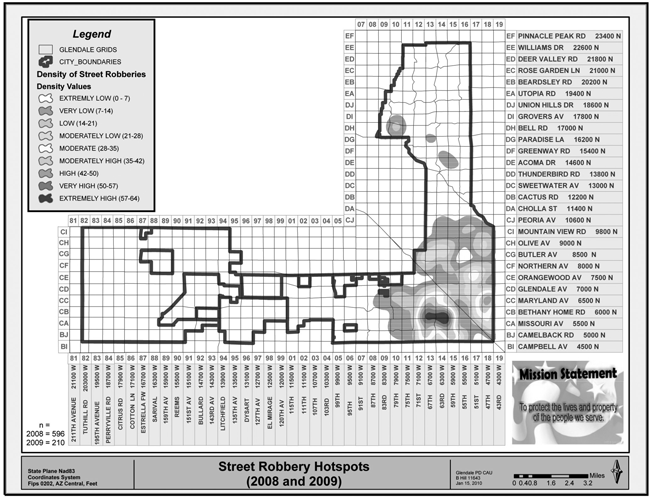
Locations. Most street robberies occur in urban areas. U.S. robbery victimization rates are about twice as high for urban residents than suburban residents.13 This trend is similar in England and Wales. Almost half (44%) of street robberies occur one mile or less from the victims' homes—perhaps because people are near home most of the time or offenders specifically target them near their homes. Other frequent robbery locations include parking lots and garages—followed by parks, fields, playgrounds, and areas near public transportation.14 Street robberies associated with public transportation are more prevalent in areas like larger cities, where its availability and use are common.
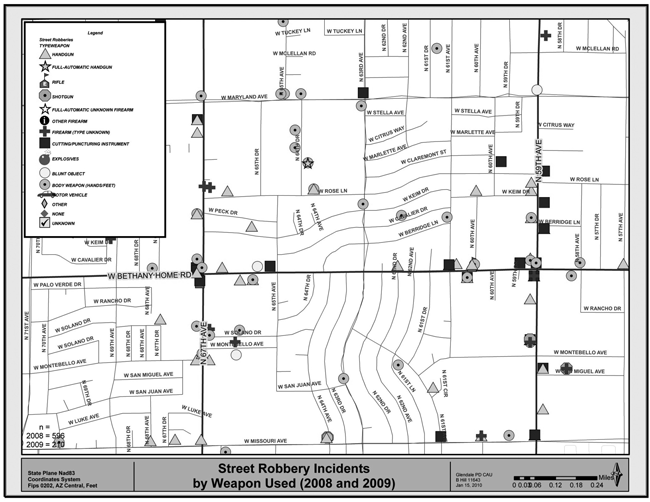
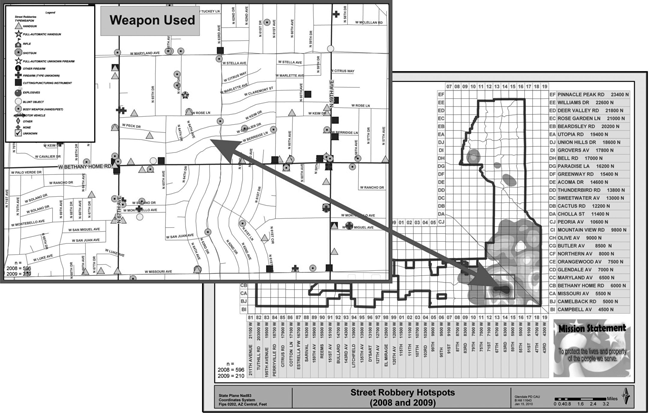
Targets
Finally, street robbers tend to take certain items during a robbery: cash, purses, wallets, credit cards, mobile phones, MP3 players, jewelry, clothing, and other small electronic devices (e.g., cameras and smaller laptop computers). The proliferation of small, portable, expensive electronic items (see figure) may be linked with street robbery in some locations.15 The items listed above are "hot products"16 that have similar CRAVED characteristics:
- Concealable—the robber can hide the items on his or her person
- Removable—the robber can easily take the items from the victim
- Available—the items are commonly found on potential victims
- Valuable—the items are useful to the robber or others
- Enjoyable—the items are fun to use
- Disposable—the robber can easily sell the items to or trade the items with others17

Harms Caused by Street Robbery
Street robbery is a major source of fear among the public because victims face a sudden threat to life, a loss of control, and an invasion of personal space.18 Street robbery is an especially fear-inducing crime because of the context in which it is likely to occur—during the course of someone's routine activities. For instance, the 2005 National Crime Victimization Survey showed that street robbers attacked most victims on their way to or from work, school, shopping, or running errands. The risk of injury and death during an attack further substantiates the public's fear of robbery. Offenders physically attack approximately half of robbery victims, and about 20 percent require medical attention.19 In 2005, the FBI estimated that about 6 percent of all murders were robbery-related.20 Some estimates suggest occurrences of robbery-murder are even greater. The type of weapon used typically distinguishes robbery from robbery-murder. Roughly two-thirds of robbery-murders involve guns, but offenders use guns in less than one-third of robberies.21 Furthermore, gun robberies are about three times more likely to result in the victim's death compared with knife robberies, and knife robberies are about three times more likely than robberies involving other kinds of weapons.22
Factors Contributing to Street Robbery
Understanding the factors that contribute to your community's street robbery problem will help you frame your own local analysis questions, determine effectiveness measures, recognize key intervention points, and select appropriate responses.
Local analysis may reveal unique situations, not on this list, that you may need to address. You should base local analysis on the street robbery analysis triangle (Figure 1). This triangle is a modification of the widely used problem analysis triangle (see www.popcenter.org for a description). It organizes basic factors that contribute to robbery problems. Though no single factor completely accounts for the street robbery problem, the interrelated dynamics among victims, locations, offenders, and routines all contribute to street robbery patterns.
Street robberies occur when motivated offenders encounter suitable victims in an environment that facilitates robbery. A street robbery problem emerges when victims repeatedly encounter offenders in the same area. In short, a combination of circumstances will lead to a robbery, not any single circumstance. For example, a street robbery is likely to occur when an offender, pressed for cash, spots a drunken person leaving a bar alone, heading toward a poorly lit, isolated location. A pattern of robberies could occur if offenders notice drunken people taking similar routes after leaving the bar. Different types of routines can change offender, victim and location characteristics, thus altering robbery patterns (e.g., midweek work and school routines may produce different robbery patterns from weekend or holiday routines).
Depending on the specific details of a street robbery problem, the relative importance of each side of the triangle and routines will vary. Addressing any one element in Figure 1 might reduce a problem, but addressing more than one side will better ensure that the robbery problem will decline. The sections below describe each of the four factors in more detail.
Figure 1. Street Robbery Analysis Triangle.
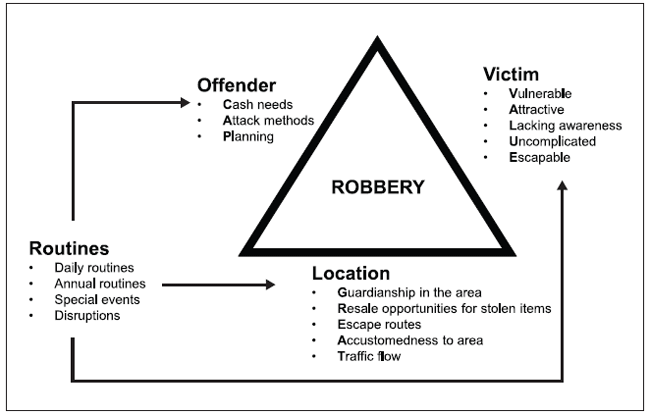
Offenders
Compared with commercial or other types of robberies, street robberies tend to be more opportunistic and occur in a more open and less predictable environment. Though some often consider street robbery a crime of opportunity involving little to no planning, street robbers do engage in decision-making processes.23 To implement the most appropriate interventions at the most appropriate locations and times, you shouldidentify, in order, what factors affect their decision-making processes. The following sections describe three factors that influence a person's decision to commit street robbery, and the acronym CAP summarizes them.
Cash needs. The immediate need for cash is a major reason why people rob. For instance, 80 out of 81 St. Louis street robbers claimed their immediate need for cash was a primary reason for committing the crime.24 Street robbery is a quick way for some to get the cash needed to purchase items related to success or status in street cultures (e.g., drugs, alcohol, fashionable clothing, jewelry, and electronics). If victims do not have cash on hand, robbers can take and sell other items to meet cash needs.
Attack methods. The ability to use certain attack methods in particular settings might also affect a person's decision to commit street robbery. Street robbers use four main attack methods: confrontations, cons, blitzes, and snatch-thefts.25 Offenders use some tactics more frequently. For example, confrontations were most common in one U.K. study (used in 37% of robberies), followed by blitzes (25%), cons (22%), and snatch-thefts (14%). These methods are not mutually exclusive and can change during the course of the robbery. Each attack method is described below.
CONFRONTATIONS. The offender demands property or possessions at the moment of contact with the victim. The offender will usually use verbal commands to gain compliance (e.g., "Give me your money"). Violence might follow if the victim does not comply.
BLITZES. The offender uses violence first to gain control over the victim (i.e., establish "who is in charge"). The actual robbery occurs after the offender immobilizes the victim.
CONS. The offender uses a distraction to catch the victim off guard. For example, an offender might ask someone for the time or directions before attacking. Using a legitimate distraction enables the robber to gain contact with the victim without causing alarm.
SNATCH-THEFTS. This tactic occurs very quickly. No verbal communication occurs between the offender and the victim before the robbery. The offender typically grabs visible property (e.g., purses and cell phones), then escapes. U.S. snatch-thefts are often combined with pick pocketing in official statistics, making it difficult to determine its true prevalence and incidence.26 In fact, a snatch-theft might be officially counted only if the victim is injured, even if the robber uses force not resulting in injury. This issue has important implications for problem analysis because crimes identified as "street thefts" are actually street robberies.
Planning. Street robberies appear tactically simple and quickly completed, but they are seldom completely unplanned. Robbers learn which tactics work in what situations based on prior experience. So what might appear as an impulsive act could be based on a plan developed from prior experience. Immediate circumstances might also affect planning. For example, a street robber might plan target selection based on the availability of weapons and accomplices. The idea is that offenders use basic planning to overcome some of the situational challenges of street robbery. Therefore, police could prevent street robbery by addressing certain situational factors. This guide's response section addresses some of these opportunity-reducing strategies.
Victims
Victim demographics are informative, but it is vital to understand how they relate to routine activities and risk. Finding that minorities have a heightened risk of street robbery in your community is helpful only as a first step. You still have to discover why. Perhaps the minorities are undocumented workers whom offenders rob because the victims often work in unfamiliar neighborhoods, carry cash and won't report the crime to the police. This scenario shows how linking demographics to routines could reveal intervention points that would otherwise have gone unnoticed by examining demographics alone. Demographic information also identifies less- promising responses. Property-marking for cell phones and MP3 players, for instance, might not reduce street robberies in areas where most victims are senior citizens who carry cash but not electronic gadgets.
For prevention purposes, it is useful to look at victims from the robber's perspective. Five characteristics of potential victims appear particularly critical, and the acronym VALUE summarizes them.
Vulnerable. Offenders prefer targets they can intimidate, subdue or overpower. For example, senior citizens or those unlikely to report their victimization to the police (e.g., drug users, prostitutes and illegal immigrants) might appear particularly vulnerable. Some targets, however, might be less vulnerable than initially perceived and able to defend themselves from an attack. In fact, using protective measures to resist robbery helped over half of U.S. victims in 2006, while aggravating the incident in less than 8 percent of cases.27
Attractive. Target attractiveness is in the eye of the robber. Therefore, attractiveness is not universal. Some robbers might be particularly attracted to people carrying a CRAVED item. Other robbers, however, might associate attractiveness with less tangible features and prefer attacking people of a particular sex, racial, or ethnic group.
Lacking awareness. Street robbers could perceive people who are distracted (e.g., using a cell phone, drunk, and/or unfamiliar with their surroundings) as easier to approach and overpower.
Uncomplicated. Offenders probably consider the ease of approaching targets. A potential target seen at a distance is likely less interesting than one nearby. How complex the robber perceives completing the robbery to be depends on the form of attack (confrontation, blitz, con, or snatch-theft) the robber usually uses.
Escapable. Offenders probably consider the ease of fleeing from targets. Robbers might altogether avoid targets they believe will chase them or use blitzes to disable them physically. Robbers might care less about escaping when some targets (e.g., senior citizens and drunken people) appear unlikely to chase or resist them. In this case, robbers might use a confrontation, a con or a snatch-theft because they don't think they have to immobilize the target.
Though considered separately, offenders probably consider VALUE as a package rather than a checklist. From a prevention perspective, however, VALUE can reveal potential countermeasures to protect possible victims.
Locations
Street robbers prefer specific locations. Often, situational features make some locations appear more attractive or suitable for committing street robbery. Offenders might consider the type of location and the characteristics and routines of the people there. Furthermore, offenders prefer locations where they can blend in with the natural "flow" and easily escape.28
Overall, offenders' journey to crime is relatively short and usually overlaps with their route to and from home.29 Some offenders lack transportation and are limited to robbing at locations within walking distance.30 Furthermore, street robbers lack information and familiarity with locations as distance increases from their homes.31 In general, younger robbers travel shorter distances than older robbers, but differences in travel distance depend on local situations (e.g., public transportation choices and street layouts).32 Finally, some street robbers prefer locations near places where they can quickly resell stolen property or buy drugs.
Pedestrian volume also influences where street robberies occur. Figure 2 illustrates the relationship between street pedestrian density and robbery: as a person moves from a center of high pedestrian activity, the number of people on the street declines. Many targets are near the center of activity, but so are high guardianship levels. Far from the center, guardianship is nearly absent, but targets are also scarce. In between these extremes, there are some robbery targets and relatively little guardianship: this is the robbery zone. The size and location of the robbery zone will vary by time of day and other routine schedules. A transit node at rush hour will push the robbery zone away because of the commuter influx. Late at night, the robbery zone may encroach on the transit node. At other times, it may disappear altogether if there are so few targets around that robbers ignore the area.
Figure 2. Pedestrian density and street robberies.
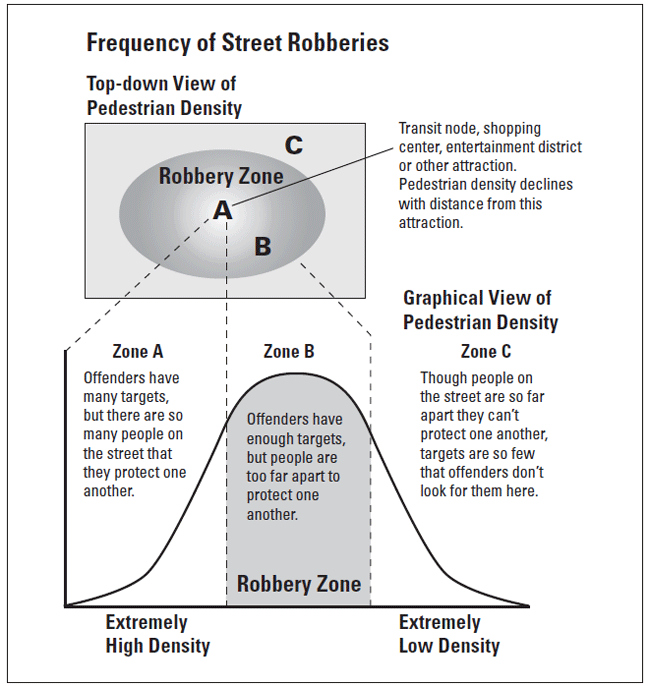
We can summarize robbery offenders' ideal locations with the acronym NEAR. Robbers are more attracted to small areas that fit these characteristics.
Natural guardianship. As mentioned, dense pedestrian and vehicle traffic increase guardianship and increase the risks for street robbers, so they prefer areas where targets are relatively unguarded. Areas with dense pedestrian and vehicle traffic, however, could thwart detection by helping offenders blend into the environment after the robbery. However, robbers may select quicker and less-obvious attack modes in dense pedestrian areas compared with less-dense areas.
Escape routes. Not only do robbers need to consider their ability to escape from a victim, but also they want routes that provide a quick escape from the crime scene.
Area familiarity. Robbers prefer familiar areas over unfamiliar areas. Being familiar with an area facilitates planning decisions and escape strategies. Familiarity also makes it easier to predict the routines of targets, guardians and police.
Resale opportunities for stolen goods. Robbers who steal noncash items for resale want to get cash and quickly dispose of evidence of the crime. Thus, robbers consider areas close to resale opportunities more desirable than areas farther away. When robbers steal only cash, they don't fear getting caught as much.
Routines
Routines influence robbery-timing patterns because routines bring robbers and targets together at locations, or they separate robbers from targets. Disruptions to routines can also influence robbery patterns. Understanding routines and disruptions is critical for understanding temporal robbery patterns. Many types of routines can influence robbery patterns. Here, we list only some of the most common. Routines vary from city to city and neighborhood to neighborhood because some areas have special routines that others don't. We use the acronym SHADE to summarize some of the routines that can influence street robbery.
Special events. Special events, like sports games, festivals and marathons, draw a lot of nonresidents to unfamiliar areas. Visitors might inadvertently make decisions that increase their risk of victimization (e.g., parking in a high-crime area). Event-goers also have several characteristics that make them attractive robbery targets: some drink and become less aware of their immediate surroundings, many stay out later than usual, and they likely have cash or other CRAVED items. Finally, police might close normal travel routes to accommodate event traffic. Some pedestrians might take less-familiar and riskier routes.
Holidays. Certain holidays [e.g., Black Friday (the day after Thanksgiving, which is the busiest shopping day of the year in the United States)] increase the availability of victims in public with cash, presents and other CRAVED items. Victims might also be more vulnerable during holidays on which they might consume larger amounts of alcohol, such as New Year's Eve and the United States' St. Patrick's Day, Fourth of July and Memorial Day.
Annual routines. The beginning of the school year increases the number of CRAVED33 products (e.g.., new clothes and laptop computers) and new students unfamiliar with places and routes near school buildings. Holiday breaks may also influence robbery patterns, either by removing students from robbery-prone areas, or by shifting their activities from relatively safe to relatively unsafe areas.
The timing of the school year also has implications for street robbery in college towns or areas with universities for the reasons mentioned above. In addition, events tied directly to the beginning of school, such as homecoming weekend, could draw large crowds of students, parents and other patrons to high-risk areas. Robbers might also target college students who go out at night or use drugs and alcohol throughout the school year. Working with campus police could shed light on the types of students most at risk and on high-risk times and locations. Other annual routines include seasonal work (e.g., landscaping and construction) and vacationing.
Disruptions to routines. Street repair and construction activity could force pedestrians off normal travel paths into unfamiliar locations. Furthermore, to save time, some pedestrians might try to avoid detours via unsafe alleys or side streets. Finally, street robbers could use construction debris as a weapon.§
§ We've taken this example from a 2006 Downtown Cincinnati Inc. Safe/Clean meeting.
At the same time, however, street repair and construction could reduce street robberies. For instance, offenders might avoid suitable robbery locations if construction crews are there. Furthermore, pedestrian traffic disruptions could reduce the number of potential victims in certain areas. Finally, temporary construction alters locations normally familiar to street robbers.
It might be difficult to determine if a robbery pattern results from construction because work sites frequently change. Similarly, construction may temporarily disrupt a robbery hot spot, making the underlying conditions that facilitate robberies harder to discover. Mapping street robberies before, during and after construction may provide information for the police to use to reduce robbers' opportunities during street repairs and construction.
Everyday routines. Certain everyday routines influence street robbery patterns, such as the following:
THE SCHOOL DAY (Grades K-12). Daily student routines based on the beginning and end of the school day could influence street robbery patterns (e.g., a cluster of robberies of students carrying MP3 players near a path to school between 7 a.m. and 8 a.m.).
COMMUTING PATTERNS. Morning and evening rush hours move commuters in and out of cities in a short time. How rush hours affect robbery patterns might vary from city to city and neighborhood to neighborhood because targets and natural guardianship both increase.
PAY ROUTINES. Regular payment schedules for some workers could influence street robbery patterns. Workers paid in cash daily (e.g., waitstaff and day laborers) are obvious targets as they go home. However, robbers might target even workers paid by check if they routinely cash their checks at the same time and place. In either case, the point is that a robbery problem could emerge if offenders identify certain times, days and places when specific people will have cash on hand. Thus, pay routines might influence street robberies near quick-loan stores, liquor stores, off-track betting parlors, bars, or other places commonly visited on paydays.
ENTERTAINMENT ROUTINES. Entertainment districts also experience an ebb and flow of pedestrian and vehicle traffic that could influence street robbery patterns. When crowds are dense, robberies will likely occur on the periphery of entertainment zones and may peak late in the evening as people go home (see Figure 2).
The discussion so far has shown who commits robberies (offenders) against what targets (victims), and where robberies will take place (locations) and when (routines). These situational factors might affect the specific techniques street robbers use. Table 1 shows how street robbery techniques might vary by the configuration of basic factors on the problem analysis triangle.
Table 1. Summary of Robberies§
| Type of Robbery | How It Works | Works Best If... | Considerations |
|---|---|---|---|
| Blitz | Offenders use immediate violence to gain control. | ...victims are isolated, and offenders can immediately physically immobilize them, using surprise. | A blitz is not useful in most crowds. Can be used when escape routes are limited. |
| Snatch-theft | Offenders spot visible items. They quickly take them without verbal demands. | ...locations are crowded, there are many escape routes and crowds impede victims and allow offenders to escape by blending into them. | This is useful for many smaller offenders who can distract the victim. Multiple offenders can hide the snatch. It does not require weapons. Offenders must look like they belong in the area. |
| Confrontation | Offenders approach victims with immediate verbal demands. Violence is possible but not necessary. | ...victims are isolated, offenders can approach them without alerting them, and offenders can use overwhelming threats. | Guns (real or fake) can substitute for the numbers and sizes of offenders. Distracted, impaired or encumbered victims are better for robbers. Victims may not have much of value. |
| Con | Offenders use distractions to make contact with victims, then rob them. | ...victims do not feel threatened by the place or offenders, and valuable items are visible and within reach. | Offender can use this method in both a crowd and in isolation. Offenders need a weapon only as a backup. |
§ These tactics are not mutually exclusive. For instance, though violence is a main component of blitz robberies, violence could also ensue in cons and confrontations if primary methods fail.
Free Bound Copies of the Problem Guides
You may order free bound copies in any of three ways:
Online: Department of Justice COPS Response Center
Email: [email protected]
Phone: 800-421-6770 or 202-307-1480
Allow several days for delivery.
Email sent. Thank you.
Street Robbery
Send an e-mail with a link to this guide.
* required
Error sending email. Please review your enteries below.
To *
Separate multiple addresses with commas (,)
- Your Name *
Your E-mail *
Copy me
Note: (200 character limit; no HTML)
Please limit your note to 200 characters.